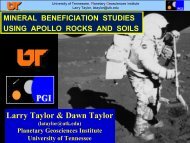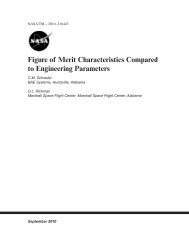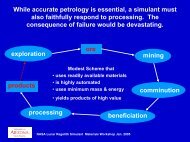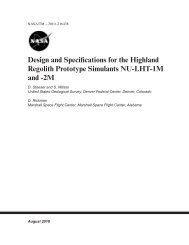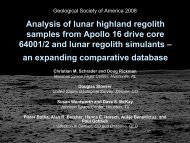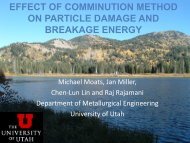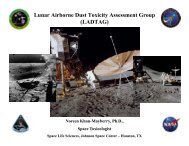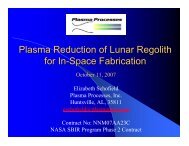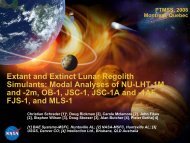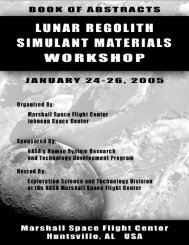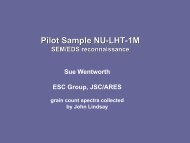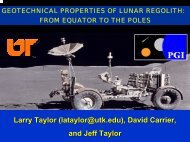NU-LHT-1M PILOT - NASA
NU-LHT-1M PILOT - NASA
NU-LHT-1M PILOT - NASA
- No tags were found...
You also want an ePaper? Increase the reach of your titles
YUMPU automatically turns print PDFs into web optimized ePapers that Google loves.
<strong>NU</strong>-<strong>LHT</strong>-<strong>1M</strong><strong>NASA</strong>/USGS - LUNAR HIGHLANDS TYPE – v.<strong>1M</strong>EDIUM-GRAINED (
WHY & WHAT• Why <strong>LHT</strong> simulants? If we put a base at thepoles, the base will be on a highlands typeregolith and therefore highlands regolithsimulants are needed.• We used an average Apollo 16 regolith targetcomposition.• The bulk of our material came from the StillwaterComplex in Montana which has long beenproposed as a source of materials for highlandsimulants.
<strong>LHT</strong>-SOURCE MATERIALS• The Stillwater Mining Company is actively supporting the simulanteffort. The SMC is mining platinum and palladium from the Complexin the basal norite zone (from the “J-M Reef”, 6-9 ft wide & 28 mileslong).• Both the highlands and the Stillwater are composed of the samemajor minerals: plagioclase (Na-Ca-Al-Silicate), pyroxenes and olivine(Fe-Mg silicates).• The lunar highlands regolith has the overall composition of aanorthositic gabbro-norite (~75-83% calcic-plagioclase, ave. ~ An94).• The Stillwater Complex is a mafic layered intrusion consisting ofhartzburgite, orthopyroxenite, norite, gabbro-norite, gabbro, andanorthosite.• <strong>LHT</strong>-<strong>1M</strong> is completely composed of rock materials from the StillwaterComplex, except for ilmenite obtained courtesy of Iluka Resources.• <strong>LHT</strong>-<strong>1M</strong> glasses were made from Stillwater Mill waste.
Simulant requirements• Proper MineralogyAppropriate chemical compositionAbsence of alteration minerals• Optimal particle size distribution• Appropriate shape distribution• Major glass contentHigh quality (HQ) glassAgglutinate (LQ) glass
Development approach• Target average Apollo 16 lunar soil composition<strong>NASA</strong> conference pub 2255 (1982)• Chemical analysis of starting constituents• USGS blending program optimizes mixture• Mixture is modified to include bestmineralogical composition
Chemical composition starting materialsSample ID SiO 2 Al 2 O 3 Fe T O 3 MgO CaO Na 2 ONorite 49.4 23.72 4.07 8.17 13.6 0.84Anorth. 48.6 30.9 1.54 1.47 15.9 1.7Harz. 43.7 2.1 13.1 38.3 1.87
Components usedMaterial Amount % of totalNorite 38 lbs 30.0Anorthosite 55 43.4Hartzburgite 7.7 6.1Ilmenite 0.92 0.73Glass 25 19.7HQ glass 5 (20)LQ glass 20 (80)
Simulant preparation• Starting material crushed
<strong>LHT</strong>-<strong>1M</strong> compositionOxide Apollo 16 <strong>LHT</strong>-<strong>1M</strong>SiO 2 44.9 47.6Al 2 O 3 25.0 24.4FeO 8.4 4.3MgO 5.8 8.5CaO 15.7 13.1Na 2 O 0.47 1.4
Glass production• Need to develop technology for glass productionHQ glassAgglutinate (LQ) glass• High throughput 100’s kg per day• Excellent temperature control• Able to handle geologic source material (powder)• High temperature plasma
Plasma Technology• Remotely-coupled transferred arcs– Non-conductive material rapidly heated / cooled– Extreme thermal gradient– Power density - 140 MW/m 3• Glass exit temperatures 1,300–1,925 °C. Up to 150 kg/hr• Plasma temperatures 13,000˚K to 21,000˚K– Typically run at 600 to 1,200 amps<strong>LHT</strong> glassmanufacturing
Agglutinate production• Partially melted material• Irregular internal structure, vesicles• Very friable• Production rates at 50+ kg (110+ lbs) per day
Movie clip
Morphology is right on for thesebigger blobs – lots of melt, littlebits sticking to bigger bits,spherules sticking to everything
SEMGlass spherules are rare to isolated. This one isfirmly attached to larger vesicular glass.Glass has Mg-rich highlands compositionregardless of shape, and is homogeneous.No inclusions have been identified in glass.Nothing found in sample that looks like agglutinate.Found isolated ilmenite(?), a Zr-rich grain, and a grainconsisting of Si, Al, C, and O.OSiglassAlsjwMgNaCaOSitypical plagioclaseAlNaCaGlass constituents (in order ofdecreasing peak height, which qualitatively correlates toabundance ): O, Si, Al, Mg, Ca, Na, Fe.Composition is excellent approximation to those of manylunar highland impact glasses .
System overviewBruker AXS X-raydetectorsCarl Zeiss custom SEMQEMSCAN ® uses advanced e-beamtechnology from Carl Zeiss andcombines this with high resolutionBSE and SE imaging, and state-ofthe-artEnergy DispersiveSpectrometers. It integrates theseusing iDiscover software to providea solution capable of identifyingmost rock-forming minerals in justmillisecondsIntellection QEM*SEM®integrated controlhardwareIntellection iDiscoversoftware suiteanalytic
QEMSCAN ® ResultsDigital photograph of a 30mm diameterpolished blockQEMSCAN ® false-coloured, digitalparticle mineral map montage of apolished block
Modal Composition and Repeatability<strong>NU</strong>-<strong>LHT</strong>-<strong>1M</strong> : C <strong>NU</strong>-<strong>LHT</strong>-<strong>1M</strong> : BCaMg Fe Glass 26.0 26.8M g FeAl Silicate 0.5 0.5Ca Al Silicate Glass 1.7 2.2M g Silicates 1.3 1.4Olivine 3.5 3.6Orthopyroxene 7.6 6.8Clinopyroxene 8.3 8.2K Feldspar 0.1 0.1Plag ioclase (An60-An100) 45.6 44.6Plag ioclase (Ab-An60) 4.1 4.1Quartz 0.2 0.2Ilm enite 0.6 0.4Chromite 0.1 0.<strong>1M</strong>ag netite 0.1 0.3Iron 0.0 0.5Others 0.3 0.4Total 100 100
Simulant Particle Shape - Quantified<strong>NU</strong>-<strong>LHT</strong>-<strong>1M</strong>: BWell RoundedRoundedSub RoundedSub AngularAngularVery Angular<strong>NU</strong>-<strong>LHT</strong>-<strong>1M</strong>: C <strong>NU</strong>-<strong>LHT</strong>-<strong>1M</strong>: BVery Angular 3.5 2.5Angular 5.8 4.8Sub Angular 17.2 15.9Sub Rounded 44.3 44.0Rounded 29.1 32.6Well Rounded 0.2 0.2Total 100 100<strong>NU</strong>-<strong>LHT</strong>-<strong>1M</strong>: C0 20 40 60 80 100Mass %
Production plans• Create a prototype material <strong>NU</strong>-<strong>LHT</strong>-2MImprovements from <strong>LHT</strong>-<strong>1M</strong> effortAddition of minor minerals - fidelityNanophase iron in agglutinate?More spheroids• 900 – 1000 pounds• Expected completion date 1-1-08
Acknowledgements• Stillwater Mining company - Dave Ryckman• JSC collaboratorsJohn Lindsay, Sara Nobel, Susan Wentworth• Horiba instruments, shape/size analysis• Zybeck Advance Products – Mike Weinstein• Intellection - Alan Butcher



